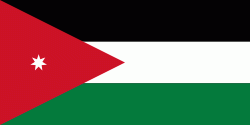Umm ar-Rasas (Umm ar Raşāş)
Umm ar-Rasas (أم الرّصاص), ancient name: Kastron Mefa'a, is located 30 km southeast of Madaba in the Amman Governorate in central Jordan. It was once accessible by branches of the King's Highway, and is situated in the semi-arid steppe region of the Jordanian Desert. The site has been associated with the biblical settlement of Mephaat mentioned in the Book of Jeremiah. The Roman military utilized the site as a strategic garrison, but it was later converted and inhabited by Christian and Islamic communities. In 2004, the site was inscribed as a UNESCO World Heritage Site, and is valued by archaeologists for its extensive ruins dating to the Roman, Byzantine, and early Muslim periods. The Franciscan academic society in Jerusalem, Studium Biblicum Franciscanum (SBF), carried out excavations at the north end of the site in 1986, but much of the area remains buried under debris.
Particularly during the epochs of the Early Bronze Age III-IV, Iron Age II, and Roman-Byzantine eras, dense populations inhabited the topographical regions beyond the western banks of the Dead Sea. Among these ancient settlements, the site of Mephaat has been mentioned in biblical texts as one of the cities upon the plateau to be condemned to great destruction (Jeremiah 48:21). Many branches of the King's Highway provided a means for reaching the more remote ancient cities, but the main route served as the forerunner for the Via Traiana Nova built by the Roman Emperor Trajan (53-117 A.D.). This road with its many branches facilitated travel, and Roman military encampments were set in place along the way as a defensive measure against barbarian assaults across the Roman desert frontier known as the Limes Arabicus. Eusebius of Caesarea identified Mephaat as the camp site of a Roman army near the desert in his Onomasticon (K.128:21). Also, the excavation of a Byzantine church here exposed an inscription naming the area as "Castron Mephaa" further supporting the theory that Umm-ar Rasas and the biblical Mephaat are one and the same.
Particularly during the epochs of the Early Bronze Age III-IV, Iron Age II, and Roman-Byzantine eras, dense populations inhabited the topographical regions beyond the western banks of the Dead Sea. Among these ancient settlements, the site of Mephaat has been mentioned in biblical texts as one of the cities upon the plateau to be condemned to great destruction (Jeremiah 48:21). Many branches of the King's Highway provided a means for reaching the more remote ancient cities, but the main route served as the forerunner for the Via Traiana Nova built by the Roman Emperor Trajan (53-117 A.D.). This road with its many branches facilitated travel, and Roman military encampments were set in place along the way as a defensive measure against barbarian assaults across the Roman desert frontier known as the Limes Arabicus. Eusebius of Caesarea identified Mephaat as the camp site of a Roman army near the desert in his Onomasticon (K.128:21). Also, the excavation of a Byzantine church here exposed an inscription naming the area as "Castron Mephaa" further supporting the theory that Umm-ar Rasas and the biblical Mephaat are one and the same.
Map - Umm ar-Rasas (Umm ar Raşāş)
Map
Country - Jordan
 |
 |
| Flag of Jordan | |
Modern-day Jordan has been inhabited by humans since the Paleolithic period. Three stable kingdoms emerged there at the end of the Bronze Age: Ammon, Moab and Edom. In the third century BC, the Arab Nabataeans established their Kingdom with Petra as the capital. Later rulers of the Transjordan region include the Assyrian, Babylonian, Roman, Byzantine, Rashidun, Umayyad, Abbasid, and the Ottoman empires. After the Great Arab Revolt against the Ottomans in 1916 during World War I, the Greater Syria region was partitioned by Britain and France. The Emirate of Transjordan was established in 1921 by the Hashemite, then Emir, Abdullah I, and the emirate became a British protectorate. In 1946, Jordan gained independence and became officially known in Arabic as the Hashemite Kingdom of Jordan. The country captured the West Bank during the 1948 Arab–Israeli War and annexed it until it was lost to Israel in 1967. Jordan renounced its claim to the territory in 1988, and became the second Arab state to sign a peace treaty with Israel in 1994.
Currency / Language
| ISO | Currency | Symbol | Significant figures |
|---|---|---|---|
| JOD | Jordanian dinar | دا | 3 |
| ISO | Language |
|---|---|
| AR | Arabic language |
| EN | English language |















